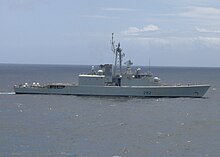Iroquois class
|
|
|
|---|---|
| Iroquois class | |

|
|
| Overview | |
| Type | destroyer |
| units | 4, all out of service |
| period of service |
July 29, 1972 to March 10, 2017 |
| Technical specifications | |
| displacement |
5,100 ts |
| length |
129.8 m |
| width |
15.2 m |
| Draft |
4.7 m |
| crew |
280 |
| drive |
|
| speed |
29 knots |
| Armament |
|
| helicopter |
2 × CH-124 Sea King |
The Iroquois- class , also known as the Tribal class , was a class of four destroyers in the Royal Canadian Navy . They were put into service in the 1970s, initially with submarine hunting as their main task. In the 1990s, the destroyers were completely overhauled and also expanded for extensive air defense . On March 10, 2017, the HMCS Athabaskan was the last unit of this class to be decommissioned by the Royal Canadian Navy.
Original concept
The ships were designed as long-range destroyers. The range is approx. 8300 km. The Iroquois class represented a new development in the history of the Canadian Navy. There is enough space on the flight deck for two CH-124 Sea King helicopters. The larger flight deck made it possible to maintain the helicopters better than in the past. For underwater battles the helicopters supported the destroyer, each of which was equipped with two triple torpedo tubes for Mk.44 and Mk.46 Mod. 5 torpedoes . They also had Limbo Mark 10 depth charges and a fully automatic 127/54 Compact ship gun. An eight - fold launcher for RIM-7 Sea Sparrow , a radar-controlled air defense system, was available for air defense.
Modifications in the Gulf War
The HMCS Athabaskan (DDG 282) was deployed to support the international coalition in Operation Desert Shield and Operation Desert Storm . She was the flagship of the Canadian Naval Task Group and was quickly modified for the new tasks. The modifications took place in the CFB Halifax in 1990 and included the installation of a mine avoidance sonar , a Phalanx CIWS above the Limbo Mk.10 depth charge launcher and the equipment with portable anti-aircraft guided missiles of the Blowpipe and Javelin types . The modifications made the depth charge thrower no longer usable.
Destroyer in class
HMCS Iroquois (DDG 280)
- Country: Canada (Shipyard: Marine Industries , Sorel )

- Keel laid : January 15, 1969
- Commissioning: November 28, 1970, active from July 29, 1972
- Decommissioned: May 1, 2015
- Status: out of service
- Modifications: July 3, 1992 TRUMP - installation of Mk.41 VLS for SM-2 Block III, Phalanx CIWS and Oto Melara 76/62 compact gun; Sea Sparrow (SAM) system removal.
- Operations: 6 months in the Arabian Sea as part of Operation Enduring Freedom .
HMCS Huron (DDG 281)
- Country: Canada (Shipyard: Davie Shipbuilding , Lauzon )

- Keel laying: June 1st, 1969
- Commissioning: April 9, 1971
- Active since: December 16, 1972
- Decommissioned: March 31, 2005
- Status: Sunk as a target ship as part of the TRIDENT FURY exercise on May 14, 2007 about 100 km west of Vancouver Island .
- Modifications: November 25, 1994 TRUMP - installation of Mk.41 VLS for SM-2 Block III, Phalanx CIWS and Oto Melara 76/62 Compact gun; Sea Sparrow (SAM) system removal.
- Operations:
HMCS Athabaskan (DDG 282)
- Country: Canada (Shipyard: Davie Shipbuilding , Lauzon )

- Keel laying: June 1st, 1969
- Commissioning: November 27, 1970
- Decommissioned: March 10, 2017
- Status: Demolition planned in Sydney (Nova Scotia)
- Modifications: June 4, 1994 TRUMP - installation of Mk.41 VLS for SM-2 Block III, Phalanx CIWS and Oto Melara 76/62 compact gun; Sea Sparrow (SAM) system removal.
- Operations: Operation HESTIA
HMCS Algonquin (DDG 283)
- Country: Canada (Shipyard: Davie Shipbuilding , Lauzon )

- Keel laid: September 1st, 1969
- Commissioning: April 23, 1971
- Active since: November 3, 1972
- Decommissioned: June 11, 2015
- Status: Scrapped in 2015 in Liverpool (Nova Scotia)
- Modifications: June 4, 1994 TRUMP - installation of Mk.41 VLS for SM-2 Block III, Phalanx CIWS and Oto Melara 76/62 compact gun; Sea Sparrow (SAM) system removal.
- Operations:
New acquisitions
The destroyers of the Iroquis class are to be replaced by new destroyers, the Canadian Surface Combatants , from 2021 . The new destroyers will be procured under the National Shipbuilding Procurement Strategy Program. A total of 15 new combat ships, including frigates, are to be procured for the Navy.
Web links
Individual evidence
- ↑ Canada's last Cold War destroyer retires after one last sail. MacLeans.ca, March 10, 2017, accessed March 12, 2017 .
- ^ Royal Canadian Navy - International Exercises: Huron sinks after barrage from HMCS Algonquin. Retrieved: February 3, 2012 ( Memento of the original from May 22, 2013 in the Internet Archive ) Info: The archive link was inserted automatically and has not yet been checked. Please check the original and archive link according to the instructions and then remove this notice.
- ^ Government of Canada awards contract for the disposal of former HMCS Athabaskan. January 18, 2018, accessed February 2, 2018 .
- ^ Royal Canadian Navy - CBC News National Shipbuilding Procurement Strategy to cost $ 35 billion. Retrieved May 22, 2012

